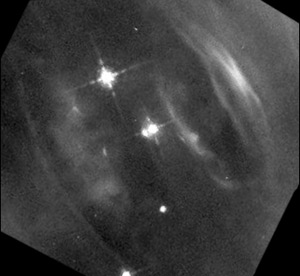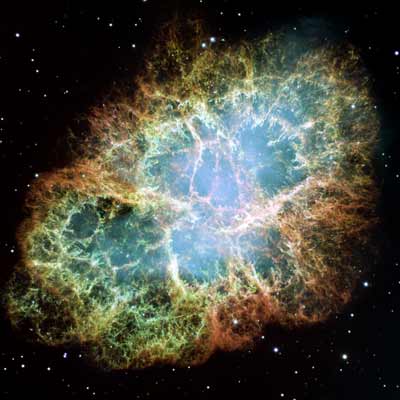A thousand years ago, and 6500 light years away from Earth, a high mass star exploded. An octillion tons of gas blasted outwards at speeds of thousands of kilometers per second, forming tendrils and wisps as it raced away. At the center of the conflagration, the core of the star had collapsed into an ultradense object called a neutron star. It has the mass of the Sun crammed into a ball only 20 - 30 km (12 - 18 miles) across, and is spinning at a rate of 30 times per second.
All this happened a long time ago. The debris is what we now call the Crab Nebula, and is one of the best-studied objects in the sky. And that’s a good thing, because even now the Crab is capable of throwing tantrums… and we can see it when it does!
This image is a brand spanking new shot of the heart of the Crab Nebula taken by the Hubble Space Telescope. And by new, I mean it was taken on Saturday, October 2! It’s a bit hard to see what’s going on, so I created an annotated version:
The pulsar is labeled. It’s sitting right at the center of the gas cloud, which extends way beyond the edges of this picture. As the pulsar spins, it emits a fast stream of particles that act like a wind, compressing the gas in the nebula and creating those circles of light. They look elliptical because the whole system is tilted, and you’re seeing it like a DVD held at an angle. From what I can tell, the bottom left is the side toward us, and the upper right is farther away, as if we’re looking down on it.
In mid-September, just a couple of weeks ago, several orbiting observatories noted that there was an increased amount of gamma rays coming from this part of the sky. Gamma rays are the highest energy form of light, and there aren’t many sources in the sky that can create them at all, let alone in quantities that can be seen. The Crab is the brightest continuous gamma-ray source we know, and so it was immediately put on the Most Wanted list.
 Hubble was quickly pointed at the pulsar, and that image above was taken. Now note the rectangular bit to the left of the pulsar. Some of that stuff was seen in earlier images, but not this bright! You can compare it to the image on the right, taken in December 1993 by Hubble, which I’ve rotated and scaled to be close to what we see in the new image. The overall structure is very roughly the same, but clearly that gas to the left is brighter in the new image. I suspect that rectangular structure in the new image is actually a ring, the shape distorted by density variations in the gas.
Hubble was quickly pointed at the pulsar, and that image above was taken. Now note the rectangular bit to the left of the pulsar. Some of that stuff was seen in earlier images, but not this bright! You can compare it to the image on the right, taken in December 1993 by Hubble, which I’ve rotated and scaled to be close to what we see in the new image. The overall structure is very roughly the same, but clearly that gas to the left is brighter in the new image. I suspect that rectangular structure in the new image is actually a ring, the shape distorted by density variations in the gas.
What must have happened [note: I’m conjecturing here and may be way off, but the basic stuff is probably correct] is that something occurred on the pulsar: maybe it had a starquake, or a bit of material fell on it (the crushing gravity of a neutron star guarantees that anything hitting it will be doing so at a large fraction of the speed of light, generating a lot of explosive energy; even a marshmallow hitting at that speed explodes like an atomic bomb!). But something violent happened, and a blast of gamma-rays ensued.
Pulsars like this have incredibly strong magnetic fields, and this can affect how matter and energy flow from the star. Apparently, a lot of this energy was directed out the poles of the star. Focused in this way, a beam of high-energy particles and energy slammed into the gas surrounding the star, lighting it up, and generating an expanding wave of pressure which created that rectangular ring, like a snowplow piling up snow.
I suspect this is the case in part due to the ring of material on the other side of the pulsar, which I marked with a dotted line. That too must be due to energy flowing out of the star’s pole. How do I know? Because if that ring were in the plane of the other circles of gas we see, it would be centered on the pulsar; literally, the pulsar would appear to be right in the center of the ring. But it’s not, it’s off-center, indicating the ring is not in that same plane. From the geometry we see, it must be above that other material, so it must have been due to material coming from the star’s poles, not its equator. For the same reason, the material on the other side – the new stuff – must be due to something happening at the other pole of the star as well.
Almost certainly, that rectangle/loop was there before this recent flare of gamma-rays occurred; it’s way too big to have been created in the past two weeks! It’s probably been there for years, carved by steady emission from the star’s pole, and this new flare lit it up. Note too that if you start at the pulsar and go through that loop, you can see a very faint arc of material even farther out (labeled in that second image). That’s just what you’d expect if a beam of matter was pouring out of the star’s pole and plowing through the surrounding gas. That arc is a shock wave where that beam ends and is ramming that material in the nebula.
 Now, this all these descriptions may sound a little dry, but remember what you’re seeing here. The above Hubble image shows a region trillions of kilometers across, tens of thousands of times larger than our entire solar system. And the energies involved are vast and numbing: in gamma rays alone, the Crab emits thousands of times the Sun’s total energy! In other words, put the Crab pulsar where the Sun is now, and we’d be cooked in seconds just from gamma rays.
Now, this all these descriptions may sound a little dry, but remember what you’re seeing here. The above Hubble image shows a region trillions of kilometers across, tens of thousands of times larger than our entire solar system. And the energies involved are vast and numbing: in gamma rays alone, the Crab emits thousands of times the Sun’s total energy! In other words, put the Crab pulsar where the Sun is now, and we’d be cooked in seconds just from gamma rays.
And this new flare of gamma rays from the Crab doubled the intensity for several days.
Yeow.
The Crab is a fantastically complicated place, with a lot going on at once. It’s hard sometimes to know what’s what. But we do get hints, and we’re getting a glimpse of its three-dimensional structure, providing essential clues to the events we’re witnessing.
Remember too: stars like these are what create nearly all the elements in the Universe besides hydrogen and helium. The iron in your blood and calcium in your bones came from stars like this that exploded billions of years ago. When we study objects like the Crab, we’re learning not just about astronomy, but literally about where we came from.
Image credits: NASA/ESA/Hubble. Tip o’ the aperture door to Evan Keane/Astronomyblog